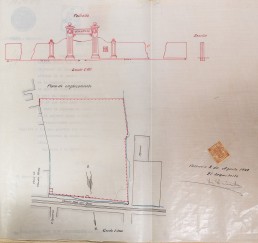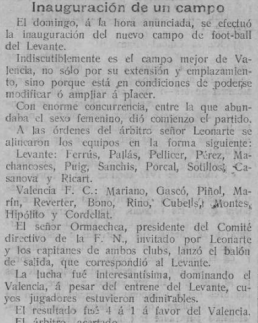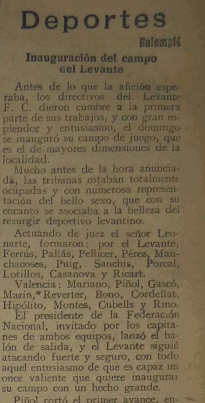Levante F.C. formally inaugurated the Campo de La Cruz, located on Camino Hondo del Grao, opposite Calle de La Conserva, on 3 September 1922 with a match that brought together Levante F.C. and Valencia F.C.
In the image shown, part of the elevation of the exterior façade can be seen, according to the drawing probably made by the architect Lorenzo Criado. The document is part of the collection in the city’s Historical Archive. The file is dated 2 August 1922. It was a major work that was a test of the potential of the marine society in the face of difficulty. The sporting value of the facility seems unquestionable. Since September 1922, the society of the Poblados Marinos had a fixed space for the realisation of its challenges in the green. In previous years, the team made its pilgrimage to the fields of Algirós and Soledad.
The event is becoming a major event. From the date set, the Levante fans have a joint destination point. It was a meeting place, easily identifiable, which became the nerve centre of the football ceremonial in which Levante F.C. took part in a fierce battle against the representatives of Valencia and Gimnástico. Within the walls of the Campo de La Cruz, a spectacle that attracted the attention of its immediate surroundings was performed on a daily basis. The Camino Hondo pitch envelops the Levante fans and captures them. It represents the passion of a football that is beginning to become a mass phenomenon.
There is a clear synergy established because it is part of their geographical domains. It establishes the beginning of a relationship that strengthens the feeling of belonging. It is a basic component for the durability and survival of sports institutions because it builds loyalty and generates clientele. There is a growth of the social mass from a double perspective: the number of members who religiously pay a monthly fee increases and the number of supporters who attend every match increases, thus increasing the box office. The latter are the embryo of future new members.
By 1925, football, represented by Levante and its different teams, was one of the spectacles that attracted the largest number of people in the Poblados Marítimos. The youngsters of Los Invencibles imposed their law on the surface of the pitch at the Campo de La Cruz. Their players defended the Levante crest, but also the honour of Poblados Marítimos. And the sun could not be beaten every time they faced a challenge. The victories were repeated forming a harmonious melody. Triumph understood as representativeness. On the grass of the facility, Levante, made up of a very high percentage of players related to Poblados Marítimos, obtained prestigious victories. The bonds of identity between Levante and its closest context were built. The Campo de La Cruz helped to solidify them.


